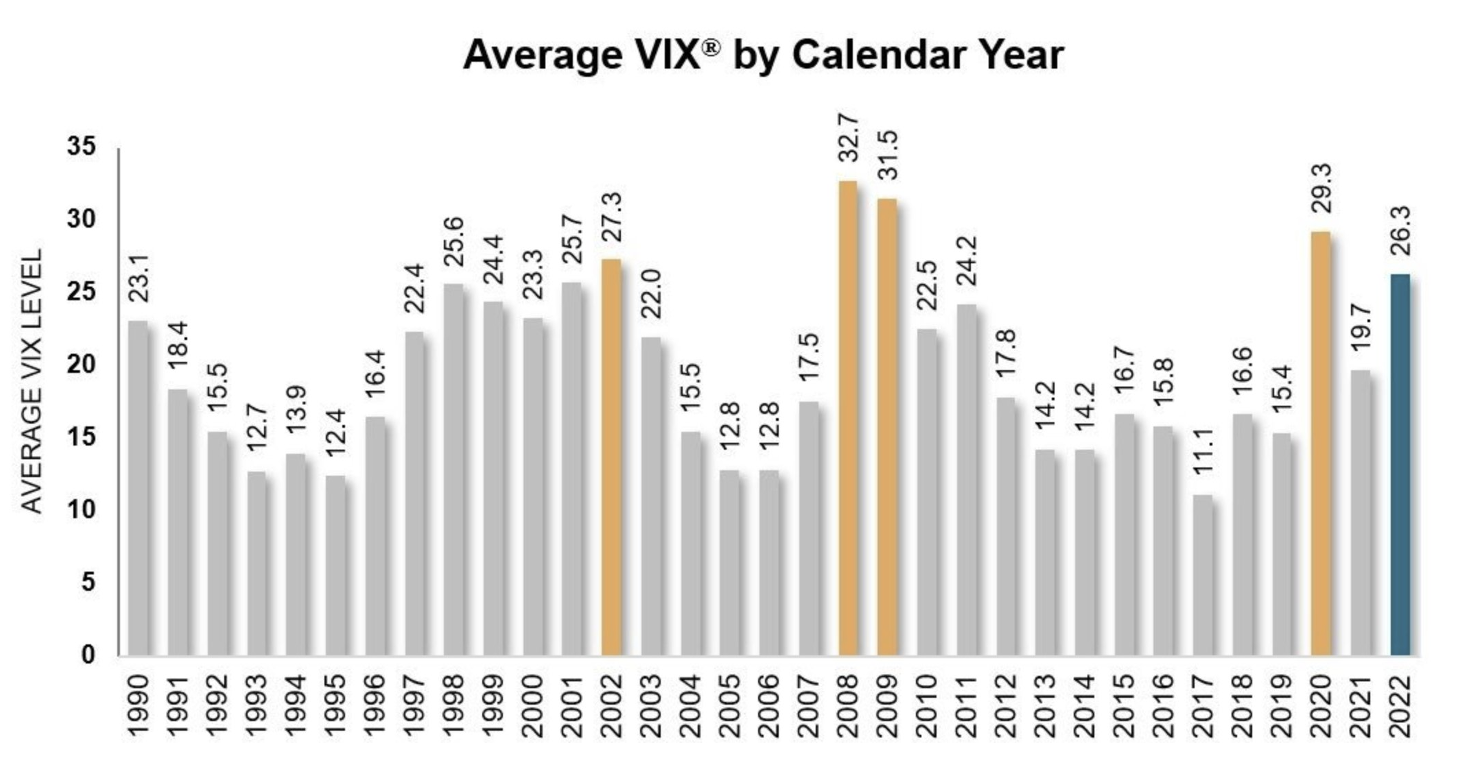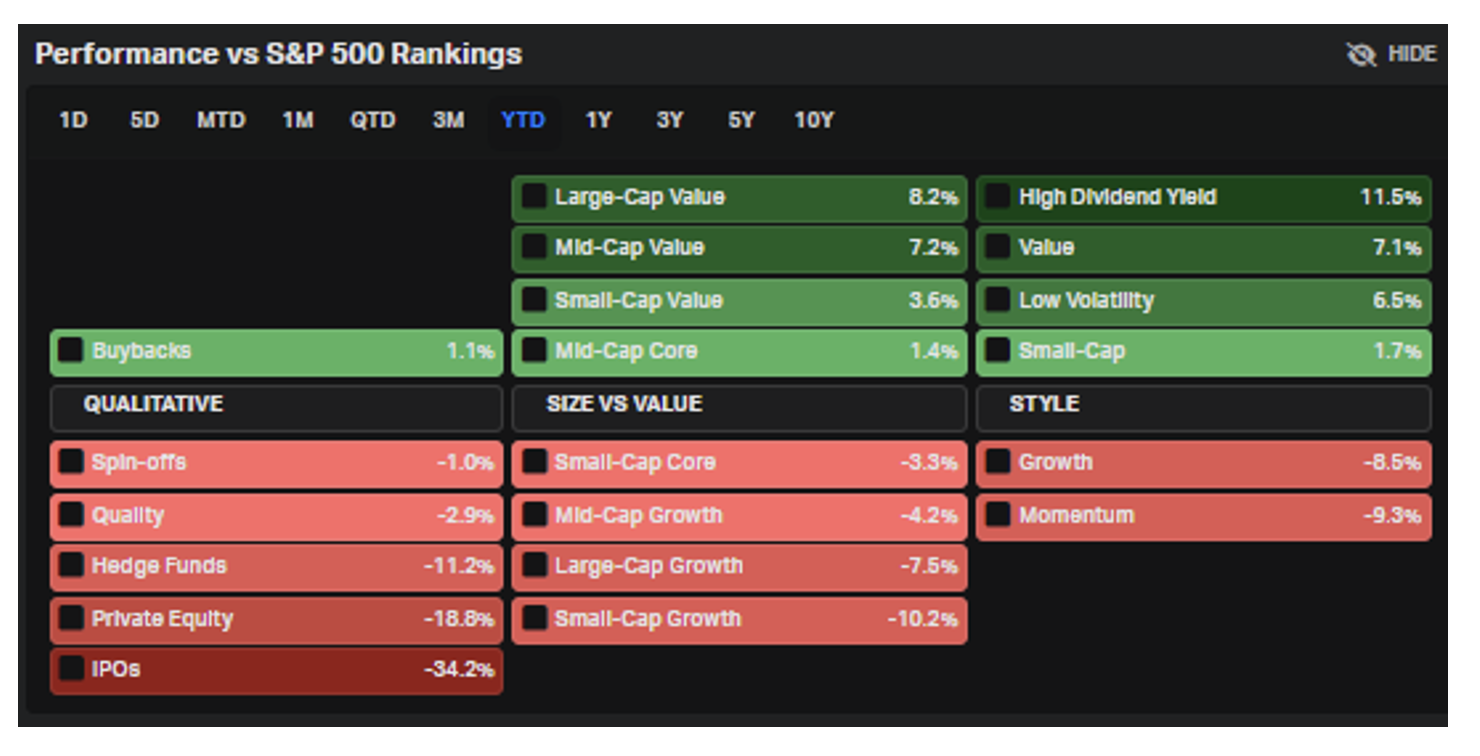Dividend Stocks Starting To Lose Their Luster
Mike Zaccardi, CFA, CMT | Jul 26, 2022 06:29
- Amid a volatile year, investors have found safety in the high dividend factor
- “Quintile 2” slice of dividend stocks has strongest risk-adjusted returns
- Portfolio managers overweight high yield sectors suggesting downside risks ahead
Volatility has pulled back recently with the VIX inching down to near the 20 level. Still, daily swings have been bigger than normal this year—2022 is pacing to be the year with the fifth highest average VIX level since 1990, according to data from Seth Golden. Expect volatility to continue to be elevated through this uncertain earnings season and ahead of the U.S. mid-term elections. History shows that significant S&P 500 dips can happen during the third quarter of year two of the election cycle.
Volatility Running High In 2022

Source: Seth Golden
Amid all that volatility, investors have found some solace in hasn’t been working this year are risky IPO stocks, growth companies and some small-cap areas.
YTD S&P 500 Factor Relative Performance

Source: Koyfin Charts
Honing in on dividends, it’s important to recognize that not all dividend stocks are created the same. According to research from WisdomTree ETFs, the so-called “2nd Quintile” has historically been the best niche to park your dividend allocation. Quintile 2 is simply the group with the second-highest yield (Quintile 1 stocks are the highest of high yielders, which tend to be overly risky). The second quintile usually houses companies with the right balance of a high payout rate without venturing too far up the risk spectrum.
Risk & Return Dividend Winner: Second Quintile
Source: WisdomTree
I found that research from Bank of America supports WisdomTree’s conclusion. The highest Sharpe Ratio among the five dividend groups is decidedly Quintile 2. Right now, that group of stocks yields from 2.46% to 3.49%, according to BofA. Performance-wise, Quintile 2 has beaten the Russell 1000 equal-weight index over the 3- and 5-year periods and since tracking began in 2010.
BofA: Quintile 2 Stands Out
Source: BofA Global Research
How can dividend-focused investors play this long-term, evidence-based trend of solid risk-adjusted returns from the second highest yielding quintile of U.S. stocks? In a note published last year, BofA addressed this question I posed to them: What ETF best tracks Quintile 2?
The answer: Vanguard High Dividend Yield Index Fund ETF Shares (NYSE:VYM). The ETF’s beta to Quintile 2 and its overall performance best replicates BofA’s screen.
The Dividend Play: VYM
Source: BofA Global Research
The Technical Take
As the growth style has rebounded sharply since the S&P 500’s mid-June low, value and dividend themes have struggled on a relative basis, however. While VYM has bounced from under $100 to about $104 at the high last week, I see resistance around that snap-back spot. Support is seen at the pre-pandemic highs in the mid-$90s.
VYM Technical Chart: Testing Resistance, Support at the Early 2020 Highs:
Source: Stockcharts.com
I also worry about positioning and sentiment in the near term with dividend-focused investing themes. The latest Bank of America Global Fund Manager Survey suggests defensive sectors are crowded. The report published last week shows the utilities, staples and healthcare sectors are the most overweighted by portfolio managers since May 2020.
Positioning Suggests Too Much Optimism In Defensive Areas
Source: BofA Global Research
The Bottom Line
I like the idea of having a reasonable long-term allocation to dividend stocks, but dividends alone should not be a reason to invest. Instead, taking a total return approach is wise. For that slice of your portfolio, however, owning something like VYM might make sense, given its exposure to what has worked historically – owning high-yield stocks, but not overly risky ones. Near term, I see downside risks to VYM considering the technical picture and positioning and sentiment.
Disclaimer: Mike Zaccardi owns VYM but none of the other securities mentioned in this article.
Trading in financial instruments and/or cryptocurrencies involves high risks including the risk of losing some, or all, of your investment amount, and may not be suitable for all investors. Prices of cryptocurrencies are extremely volatile and may be affected by external factors such as financial, regulatory or political events. Trading on margin increases the financial risks.
Before deciding to trade in financial instrument or cryptocurrencies you should be fully informed of the risks and costs associated with trading the financial markets, carefully consider your investment objectives, level of experience, and risk appetite, and seek professional advice where needed.
Fusion Media would like to remind you that the data contained in this website is not necessarily real-time nor accurate. The data and prices on the website are not necessarily provided by any market or exchange, but may be provided by market makers, and so prices may not be accurate and may differ from the actual price at any given market, meaning prices are indicative and not appropriate for trading purposes. Fusion Media and any provider of the data contained in this website will not accept liability for any loss or damage as a result of your trading, or your reliance on the information contained within this website.
It is prohibited to use, store, reproduce, display, modify, transmit or distribute the data contained in this website without the explicit prior written permission of Fusion Media and/or the data provider. All intellectual property rights are reserved by the providers and/or the exchange providing the data contained in this website.
Fusion Media may be compensated by the advertisers that appear on the website, based on your interaction with the advertisements or advertisers.